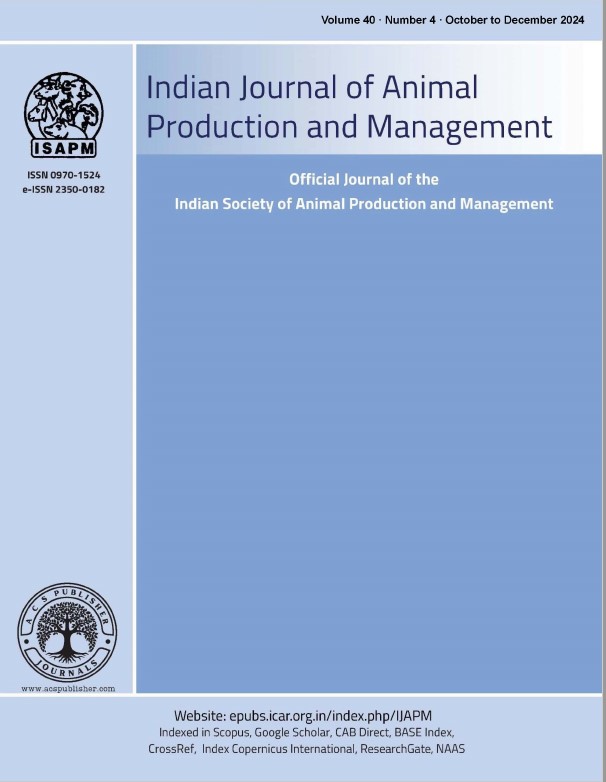Immunological and Histopathological Study for Broiler’s chicken Infected with H9N2 Avian Influenza Virus
DOI:
https://doi.org/10.48165/ijapm.2025.41.2.6Keywords:
Avian influenza (AI), bird flu, contagious, infection, widespreadAbstract
Avian influenza (AI), commonly known as bird flu, is a highly contagious viral infection that affects a wide range of bird species, including domestic poultry. Among the various subtypes of avian influenza viruses, H9N2 is one of the most widespread and economically significant low pathogenic avian influenza viruses (LPAIV) in poultry. First identified in the 1960s, H9N2 has since become endemic in many regions, particularly in Asia, the Middle East, and North Africa (Peacock et al., 2019). Although it is classified as low pathogenic, meaning it typically causes mild clinical signs, H9N2 can still lead to substantial economic losses in the poultry industry due to reduced egg production, poor growth rates, and increased susceptibility to secondary infections (Butt et al., 2002).
References
Bóna, M., Kiss, I., Dénes, L., Szilasi, A., & Mándoki, M. (2023). Tissue tropism of H9N2 low-pathogenic avian influenza virus in broiler chickens by immunohistochemistry. Animals, 13(6), 1052.
Bonfante, F., Mazzetto, E., Zanardello, C., Fortin, A., Gobbo, F., Maniero, S., ... & Terregino, C. (2018). A G1-lineage H9N2 virus with oviduct tropism causes chronic pathological changes in the infundibulum and a long-lasting drop in egg production. Veterinary Research, 49(1), 83.
Butt, K. M., Smith, G. J., Chen, H., Zhang, L. J., Leung, Y. C., Xu, K. M., ... & Guan, Y. (2005). Human infection with an avian H9N2 influenza A virus in Hong Kong in 2003. Journal of Clinical Microbiology, 43(11), 5760-5767.
Deng, G., Bi, J., Kong, F., Li, X., Xu, Q., Dong, J., ... & Qiao, J. (2010). Acute respiratory distress syndrome induced by H9N2 virus in mice. Archives of Virology, 155(2), 187-195.
Dong, J., Zhou, Y., Pu, J., & Liu, L. (2022). Status and challenges for vaccination against avian H9N2 influenza virus in China. Life, 12(9), 1326.
El-Fadl Reham, A., Awad, A. I., & Omer, A. (2019). Humoral immune response of the low pathogenic avian influenza (H9) vaccines in broilers. Assiut Veterinary Medical Journal, 65.
Essalah-Bennani, A., Bidoudan, Y., Fagrach, A., Balil, H., Abderrazak, E. K., Tligui, N., ... & Ouafaa, F. F. (2021). Experimental study of the efficacy of three inactivated H9N2 influenza vaccine on broiler flocks. German Journal of Veterinary Research, 1(2), 35-45.
Gaide, N., Lucas, M. N., Delpont, M., Croville, G., Bouwman, K. M., Papanikolaou, A., ... & Guérin, J. L. (2022). Pathobiology of highly pathogenic H5 avian influenza viruses in naturally infected Galliformes and Anseriformes in France during winter 2015–2016. Veterinary Research, 53(1), 11.
Gharaibeh, S. (2008). Pathogenicity of an avian influenza virus serotype H9N2 in chickens. Avian Diseases, 52(1), 106-110.
Mahana, O., Arafa, A. S., Erfan, A., Hussein, H. A., & Shalaby, M. A. (2019). Pathological changes, shedding pattern and cytokines responses in chicks infected with avian influenza-H9N2 and/or infectious bronchitis viruses. VirusDisease, 30(2), 279-287.
Mahmoud, S. I., Zyan, K. A., Hamoud, M. M., Khalifa, E., Dardir, S., Khalifa, R., ... & Elfeil, W. K. (2022). Effect of co-infection of low pathogenic avian influenza H9N2 virus and avian pathogenic E. coli on H9N2-vaccinated commercial broiler chickens. Frontiers in Veterinary Science, 9, 918440.
Pan, X., Su, X., Ding, P., Zhao, J., Cui, H., Yan, D., ... & Li, Z. (2022). Maternal-derived antibodies hinder the antibody response to H9N2 AIV inactivated vaccine in the field. Animal Diseases, 2(1), 9.
Peacock, T. H. P., James, J., Sealy, J. E., & Iqbal, M. (2019). A global perspective on H9N2 avian influenza virus. Viruses, 11(7), 620.
Pusch, E. A., & Suarez, D. L. (2018). The multifaceted zoonotic risk of H9N2 avian influenza. Veterinary Sciences, 5(4), 82.
Qiang, F., & Youxiang, D. (2011). The effects of H9N2 influenza A on the immune system of broiler chickens in the Shandong Province. Transboundary and Emerging Diseases, 58(2), 145-151.
Śmietanka, K., Minta, Z., Świętoń, E., Olszewska, M., Jóźwiak, M., Domańska-Blicharz, K., ... & Pikuła, A. (2014). Avian influenza H9N2 subtype in Poland–characterization of the isolates and evidence of concomitant infections. Avian Pathology, 43(5), 427-436.
Swayne, D. E., & Pantin-Jackwood, M. (2008). Pathobiology of avian influenza virus infections in birds and mammals. Avian Influenza, 28(1), 87-122.
Waheed, S. F., Aslam, A., Khan, M. R., Ashraf, K., & Anjum, A. (2022). A perspective of the prevalent H9N2 virus with a special focus on molecular and pathological aspects in commercial broiler chicken in Punjab, Pakistan. Brazilian Journal of Biology, 84, e261849.
Yang, W., Liu, X., & Wang, X. (2023). The immune system of chicken and its response to H9N2 avian influenza virus. Veterinary Quarterly, 43(1), 1-14.
Zhang, J., Huang, L., Liao, M., & Qi, W. (2023). H9N2 avian influenza viruses: Challenges and the way forward. The Lancet Microbe, 4(2), e70-e71.
Zhu, G., Wang, R., Xuan, F., Daszak, P., Anthony, S. J., Zhang, S., ... & He, G. (2013). Characterization of recombinant H9N2 influenza viruses isolated from wild ducks in China. Veterinary Microbiology, 166(3-4), 327-336.

